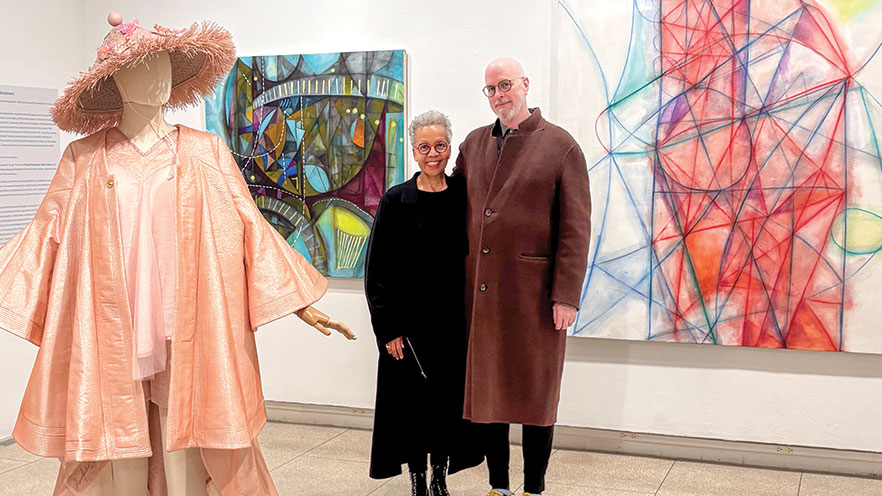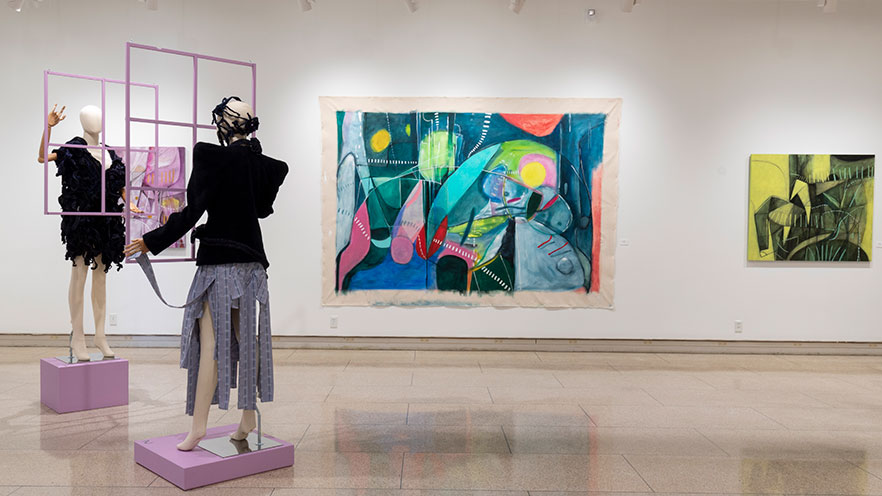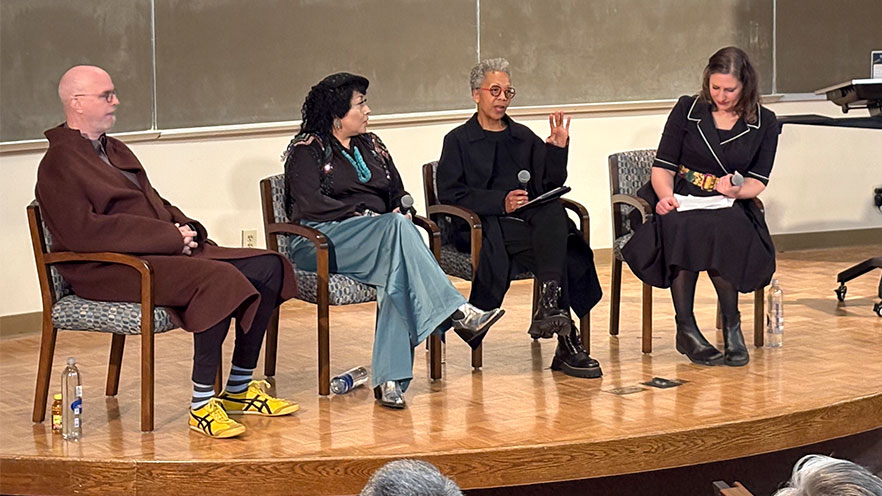Art & Fashion Come Full Circle at Whitman’s Sheehan Gallery
With their show at the Sheehan Gallery, Erik ReeL ’75 and Rhonda P. Hill found meaning in the past and hope for the future
By Melissa Welling ’99
Photography by Tara Graves

Creative synergy. Collaborators (from left) Rhonda P. Hill and Erik ReeL ’75 envisioned a show where art and fashion intersect.
In the early 1970s, Whitman College President Donald H. Sheehan envisioned a campus gallery, where Walla Wallans could enjoy the arts alongside the Whitman community. Visual artist Erik ReeL ’75 left Whitman shortly before the Sheehan Gallery opened its doors, but he remembers Sheehan’s passion for the project.
Earlier this year, ReeL returned to campus to experience Sheehan’s dream come to life—this time as an exhibiting artist, alongside his collaborator and wife, fashion curator Rhonda P. Hill.
Their show, “FACT: fashion + art construct tomorrow,” which was featured in the gallery from late January to early April, paired ReeL’s nonobjective paintings with fashions curated by Hill from up-and-coming designers Palani Bearghost, Alena Kalana and Fabiola Soavelo.
From Tea With Sheehan to Showing at Sheehan
ReeL has been an artist at heart since he was 9 years old, when his grandmother took him to a show of modernist works at the Seattle Art Museum. Fearing that Art wasn’t a practical enough major for his father, an engineer, however, he initially came to Whitman to study Math.
At the time, students met in seminar-sized groups in the homes of faculty, staff and administration members for tea and informal conversations about special topics, life at Whitman and what was happening in the world. A friend suggested that ReeL join Sheehan’s group.
“He was a very generous, very interesting president and very approachable,” ReeL recalls. Sheehan hoped the gallery would help break down barriers between Walla Walla and Whitman’s campus. “He envisioned the whole town coming.”
As ReeL made the decision to focus more on his art, he decided to switch majors—and schools—for what was, at the time, a more robust art program at the University of California, Berkeley, eventually finishing his bachelor’s degree and graduate studies in art history and critical theory at the University of Washington.
But he appreciates the liberal arts mindset he learned at Whitman and the versatility it encouraged in his later career. In the decades after Whitman, he showed his artwork at galleries throughout the West Coast and beyond; taught color theory, painting, life drawing, art history and design courses at Seattle Central College; and wrote about art and performance for a wide variety of publications. His math skills also positioned him uniquely to make significant contributions to emerging computer animation and computer-aided design technologies in the ’90s.
“If you’re slotted in art school, you’d never even think of those things,” he says. “It allowed me to work on some very interesting projects.”

Future forward. FACT examines how we must think of the future we want and asks the question, “How can you shape the future, today?”
A Show Is Born
The seeds of ReeL and Hill’s show were planted in 2020, shortly after they’d moved to Portland, Oregon. When the pandemic shut down so much of the world, they wanted to still reach out to the arts community. So they began conversations with Kynde Kiefel, who was soon to become the Director of the Sheehan Gallery.
Those conversations led to ReeL giving a virtual talk to Whitman students and faculty during lockdown—and deepening their bond with the arts community at Whitman.
When the couple checked in with Kiefel in 2021, she proposed a collaboration: ReeL’s paintings and Hill’s curated fashions on display together in the gallery.
According to ReeL, most commercial galleries don’t show fashion because it can’t be sold the same way as other artworks—and many museums don’t treat fashion as art. “So what Kynde was proposing was very innovative, very exciting,” he says.
Hill’s platform, E D G E fashion intelligence, exposes the work of emerging designers. “When I look at Erik’s work, it’s colorful, it’s complex, and it’s emotionally stimulating,” she says. “So I had to look at designers that met the caliber of his creativity—and at the same time, I wanted to find enough context, texture, color, shapes and form that would compliment his work.”
The gallery’s location at Whitman added an educational component that made the project even more interesting. Hill saw an opportunity to showcase designers practicing circular fashion: a system where apparel, footwear and accessories are designed for re-entry after use, rather than ending up in landfills. “The industry needs a wake-up call, and we do as consumers,” Hill says.
That message resonates very much with ReeL, who says he also strives for a “be light on the earth” approach to his art.
Earth-Friendly Fashion
Rhonda Hill believes that great fashion doesn’t have to sacrifice the environment—and offers a few tips for people looking to minimize their impact:
Reduce your consumption. With 100 billion new garments created by the fashion industry every year, there’s room for everyone to buy less.
Reuse what you have. Give old garments new life by repairing and restyling them.
Recycle. Give away what you don’t need anymore—and shop secondhand first.
Wash less often. Wearing garments a few times before you wash them won’t harm them and will reduce water use and pollution.
Embrace gender-neutral fashion. Shopping across gender lines can extend the life and usability of clothing by opening it up to a wider audience.
When you buy, buy quality. Look for durable pieces, preferably made from recycled materials.
About the Designers
All the designers in “FACT: fashion + art construct tomorrow” practice circular fashion, Hill says, mostly by using deadstock fabric—textile waste that went unused during the manufacturing process.
In tribute to her heritage, Palani Bearghost creates Native-inspired wearable art and collaborates with Indigenous artisans. Bearghost established her streetwear clothing company, No End Of (NEO) in 2013. “Fashion is not just about aesthetics,” she says, “it’s a form of storytelling and preserving culture.”
Los Angeles-based designer Alena Kalana creates zero-waste fashion inspired by the engineered contoured lines of Vietnamese rice fields, which are designed to prevent water erosion. She also recently started a children’s line, Luhduckie, which features reimagined, repurposed and upcycled pieces.
Fabiola Soavelo’s designs reflect her dual Swiss-Malagasy heritage and draw inspiration from science fiction—with complex silhouettes and revitalized deadstock materials, such as raffia fibers, that have deep cultural significance in Madagascar.

Center stage. In February, (from left) visual artist Erik ReeL ’75, fashion designer Palani Bearghost and fashion curator Rhonda P. Hill joined Sheehan Gallery Director Kynde Kiefel for a panel discussion about the show.
‘Beautiful Intimacy’
Their experience with Sheehan Gallery couldn’t have been better, ReeL and Hill agree.
“The Sheehan Gallery group, their ability for installation and their own creativity is far beyond what we’ve experienced in other museums,” ReeL says.
In February, ReeL and Hill spent a week on campus as part of the show. ReeL delivered an artist talk. The couple also participated in a panel discussion alongside Bearghost and Kiefel and met with senior Art majors to share feedback on thesis projects.
“It was such a strong collaboration, and the whole experience over these two years has been just wonderful,” Hill says. “I feel like there’s this beautiful intimacy here at Whitman that provides collaboration and support for each other.”
Enjoy more photos from “FACT: fashion + art construct tomorrow”: